Last Updated on January 22, 2024 by Greg Gillson
In the United States and Canada there are many birds colored primarily yellow and black. This is a common color pattern of several species of finches, tanagers, orioles, meadowlarks and warblers. There are even far more kinds of birds that are colored greenish above, yellow below, with black feathers in the plumage. I don’t cover those here.
The birds in this article are primarily bright yellow on the body with either black wings and tail or black on the head. But I include a few other birds with slightly different color patterns, in case these other birds might be the one you saw.
List of 15 Common Yellow and Black Birds
The birds most likely to be noted in your backyard or feeder, or in the countryside nearby, are these yellow and black birds, which I’ll describe further (with photos) below:
- American Goldfinch
- Lesser Goldfinch
- Evening Grosbeak
- Western Tanager
- Scarlet Tanager
- Orchard Oriole
- Scott’s Oriole
- Hooded Oriole
- Eastern Meadowlark
- Western Meadowlark
- Wilson’s Warbler
- Hooded Warbler
- Townsend’s Warbler
- Common Yellowthroat
- Yellow-headed Blackbird
When you first notice a bird it may be the color that grabs your attention but it can be tricky to identify them. Males and females may be different colors and breeding and non-breeding plumages are likely to be different. Thus the size and shape of the bird, and especially the shape of the bill, is more helpful than color for quickly narrowing down the possibilities among the world’s 10,000 species of birds (or even North America’s 1,000 species).
If you aren’t a birder, though, chances are you are asking about a very common bird in your backyard or feeder. That narrows down the possibilities greatly. I’ll start with those backyard birds, then continue on to obvious birds you may see in the countryside or woods.
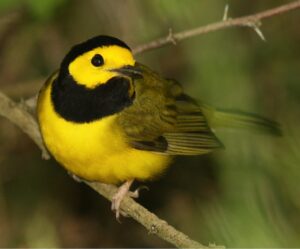
At the feeder
There are three common birds that may visit your seed feeders. If the bird you are inquiring about was in your backyard, there’s a good chance it was one of these three.
American Goldfinch
 |
|
American Goldfinch by Greg Gillson.
|
Frequently, when people ask about a bird that is bright yellow and black, or a bird that is yellow with black wings, it is the American Goldfinch. It is not the only bird so colored, as you’ll see below, but this species is common and widespread across the United States. It also is common at seed feeders, especially thistle feeders.
American Goldfinches are little yellow birds with black and white wings and tail, and a white rump and under tail. Males are much brighter yellow than females, and sport a black crown.
Length bill tip to tail tip: 5 inches.
In winter this species molts into a dull creamy brown body plumage with buffy wing bars that barely resemble the summer magnificence.
Flight is strongly undulating in the flap-bound style.
Often found in large flocks except in breeding season.
Voice: Song light and clear. In flight a 4-note lilt that can sound like po-ta-to-chip!
Lesser Goldfinch
 |
|
Lesser Goldfinch by Greg Gillson.
|
In the West, especially the Southwest, American Goldfinches are joined by Lesser Goldfinches. These little yellow birds resemble the American Goldfinches.
Lesser Goldfinches have green or even black backs. The yellow underparts, including the under tail coverts remain bright yellow, even in winter. Length bill tip to tail tip: 4-1/2 inches.
In flight the wings show a long white stripe mid-wing. Flight is strongly undulating in the flap-bound style.
Usually occurs in small flocks.
Voice: Song is sweet phrases. Calls include plaintive rising or falling pairs: Tee-yee or tee-yair.
Evening Grosbeak
 |
|
Evening Grosbeak by Greg Gillson.
|
Evening Grosbeaks nest across southern Canada and in the mountains of the western United States.
In winter they descend to the lowlands and southward. But each winter is different. In some years, when seeds are scarce in the north, huge flocks irrupt far southward. At these times they feed on maple and elm seeds, as well as in backyard seed feeders.
Plump with short tails and an over-sized greenish-yellow bill. Males have yellow belly, shoulders and forehead that merge into a smoky gray head and upper body. The tail is black. The black wings have large white secondary feather patches that are obvious in flight.
Females are pale gray but show a hint of yellow in a similar pattern, thought with additional white wing patches at the base of the primaries. Length bill tip to tail tip: 8 inches.
Voice: Often heard in flight is a clee-ip call and a whistled pew, either clear or buzzy.
In fruit trees
If one of the above 3 species weren’t the bird you saw, then we have more work to do!
There are several female tanagers and orioles that have yellow and black feathers and may appear in your shade or fruit trees during spring migration and summer. Most of these birds follow the general pattern of being yellow with black wings.
Western Tanager
 |
|
Western Tanager by Greg Gillson.
|
If you live in the West you may wake one morning in May to your trees dripping with colorful tanagers that arrived overnight! Otherwise these birds tend to spend their time in pairs hidden high in tallest conifer trees.
Bright yellow body with black wings and red head. Western Tanagers have white wing bar. Black tail. Males have red-orange heads, lacking on first year males and winter plumage.
Females are yellowish or grayish with olive-green wings and tail. The bill of both genders is pale yellowish and swollen. Length bill tip to tail tip: 7-1/4 inches.
Voice: Males sing a hoarse robin like song. The calls include a rough pi-ter-rik.
Scarlet Tanager
 |
| Female or winter male Scarlet Tanager by Félix Uribe |
Scarlet Tanagers are the Eastern counterpart of the Western Tanager.
Breeding males are bright red with black wings and tail.
But the female is dull yellowish, or greenish, with blackish or olive wings. In fall the male becomes blotchy green and red and then molts into a yellowish plumage similar to the females coloration. The bill is pale. Length bill tip to tail tip: 7 inches.
Voice: A hoarse robin-like song. Call is hoarse chip-burr.
Orchard Oriole
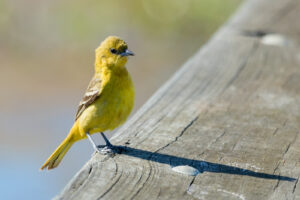 |
|
Female Orchard Oriole
by Imogen Warren
|
Orchard Oriole is smaller Eastern oriole.
Males are dark–deep chestnut and black. They have a black hood, back, wings and tail. This contrasts with the chestnut underparts.
Females are olive on the wings and upper parts, yellowish below. The immature male is yellowish below with an extensive black chin and throat (see photo above). Length bill tip to tail tip: 7-1/4 inches.
Voice: Song is a rapid burst of whistled notes downslurred at the end reminiscent of House Finch. Call a soft chuck.
Scott’s Oriole
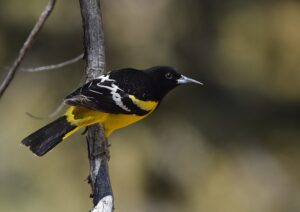
Scott’s Oriole is a bird of desert mountains and yucca in the southwest deserts.
The male is black above, including head, breast, back, wings and tail. It has white wing patches.
Females and first spring males have a variable amount of black on the face and upper breast, but are more olive above, rather than black. Length bill tip to tail tip: 9 inches.
Voice: The song is flute-like whistles similar to the song of Western Meadowlark. Harsh chuck call.
Similar species not shown: In southern Texas is Audubon’s Oriole. It is similar to Scott’s Oriole but the back is yellow.
Hooded Oriole
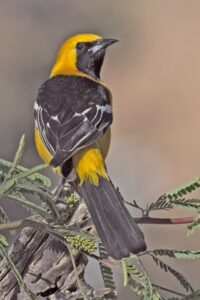
A bird of palm trees from California to Texas.
Hooded Orioles in California are a bit more yellowish than the orange birds of Texas. The males have black throat, back, wings and tail.
Females are yellow below and greenish above with dark wings. First year males are similar to females but with more yellowish under parts with black throat. Length bill tip to tail tip: 8 inches.
Voice: Song is composed of grating sounds and piping whistles. Call an up-slurred eek.
In open fields
Meadowlarks are birds of short grasslands and deserts. From above they are camouflaged black, brown and white. From the front, though, they have brilliant yellow under parts with a black band across the chest.
Eastern Meadowlark
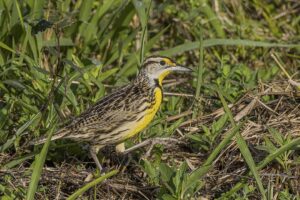
This open country songster of fields and meadows is found in the eastern United States and southwest.
Eastern Meadowlarks are speckled and streaked above in browns and blacks, darker than Western Meadowlarks. The underparts are bright yellow. A black band goes across the chest. The yellow throat is narrower than on Western Meadowlark. The malar feathers down from the lower mandible of the beak are white. Length bill tip to tail tip: 9-1/2 inches.
Voice: Song is a drawn out whistle of tee-yah, tee-yair. Call a buzzy dzrrt.
Western Meadowlark
 |
|
Western Meadowlark by Greg Gillson.
|
This grassland species is found westward from the Midwest and Texas.
Western Meadowlarks are speckled and streaked above in browns, blacks, and grays, paler than Eastern Meadowlarks. The underparts are bright yellow. A black band goes across the chest. The yellow throat is wider than on Eastern Meadowlark. The malar feathers down from the lower mandible of the beak are yellow. Length bill tip to tail tip: 9-1/2 inches.
Voice: The variable song consists to many flute-like notes. Gives a chuck call and rattle.
In woodlands
There are many warblers with yellow and black feathers. Most also include white and green plumage. I present 3 here that are primarily yellow and black. These insect gleaners are primarily found in summer, migrating south of the border in winter. An exception is the Townsend’s Warbler below.
Wilson’s Warbler
 |
|
Wilson’s Warbler. Greg Gillson.
|
Wilson’s Warblers nest across Canada, Alaska, and south in western mountains. But they may be found in migration across the United States, but tend to be more common in the West in stream tangles.
This is a small bright yellow bird with beady black eye. Only the male has the small black cap. Length bill tip to tail tip: 5 inches.
Voice: Song a long trill on one pitch, ending with a couple lower flat notes, chi chi chi chi chi chet chet. Call note a flat chimp, similar to the Pacific Wren.
Hooded Warbler
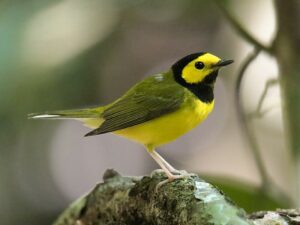
This warbler is found in the eastern United States, especially the Southeast, in wooded swamps.
Bright yellow below with a black cowl over the head, encircling the yellow face. Upper parts and tail green. White tail spots show when tail fanned, or from below.
Female has greenish hint of male’s cowl over face, but not throat. Length bill tip to tail tip: 5-1/4 inches.
Voice: Loud whistled song weeta wee-tee-o. Call is a sharp chink.
Townsend’s Warbler
 |
|
Townsend’s Warbler by Greg Gillson.
|
Townsend’s Warblers are breeding birds of conifers in western mountains from Alaska to Oregon. They winter along the West Coast.
Many warblers show a pattern of black throat, yellow and black face and streaked sides. This species has the most yellow, so that overall it appears as a yellow and black bird.
Females lack the black throat; the black crown and face of the male is replaced by olive. Length bill tip to tail tip: 5 inches.
Voice: Song starts buzzy and ends with clear notes weazy weazy seesee. Call is high pitched tip.
In marshlands
I present two common species here that do have black and yellow feathers, but are patterned differently from the birds above.
Common Yellowthroat
 |
|
Common Yellowthroat by Greg Gillson.
|
Breeds across Canada and the United States. Winters along the southern US coasts and southward.
This marsh-dweller often appears more olive brown with bright yellow throat and under tail. The black domino mask across the face is an obvious mark on the male that is lacking on the female. Length bill tip to tail tip: 5 inches.
Voice: Song of male delivered from exposed perch is loud witchety witchety witch!
Yellow-headed Blackbird
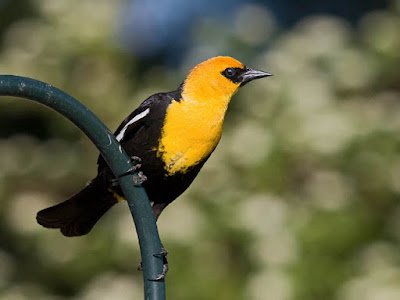 |
|
Yellow-headed Blackbird by Greg Gillson.
|
This noisy blackbird is found in marshes from central Canada, the Great Plains and the Great Basin of the United States.
The male Yellow-headed Blackbird is black with a yellow head and chest.
The female is darker on the face and neck with a blob of yellow on the chest. Both genders have white wing patches visible in flight. Length bill tip to tail tip: 9-1/2 inches.
Voice: The song is a hoarse rasping produced with much contortions. Call is a low kack.
Wrapping Up
I hope you have enjoyed reading about black and yellow birds. The question of numbers of species is always of interest. Well. if we consider any bird with significant black and yellow plumage, the number could be around 20-25 species. This includes well-known birds like American Goldfinches, Hooded Warblers, Western Tanagers, Common Yellowthroats, and Yellow-breasted Chats.
Stricter Definition: If we narrow it down to birds with a dominant black and yellow color scheme, the number drops to around 10-15 species. This excludes birds with smaller amounts of black or yellow, like Yellow-throated Warblers or Eastern Phoebes.
Regional Variation: Additionally, the specific species you might find will vary depending on your location in the US. For example, Western Tanagers are primarily found in the west, while Hooded Warblers are more common in the east.
Frequently Asked Questions
What is the most common black and yellow bird in the US?
The crown for the most common black and yellow bird in the US likely belongs to the American Goldfinch (Carduelis tristis), earning this title through multiple factors:
- Widespread Distribution: These charming finches are found throughout mainland North America, from Mexico to Canada, across various habitats like grasslands, open woodlands, and even backyards. Their adaptability allows them to thrive in diverse environments.
- Abundant Populations: Surveys and estimates consistently rank American Goldfinches among the most numerous bird species in the US. Their breeding success and resilience contribute to their large and stable populations.
- Year-Round Presence: Unlike many black and yellow birds that migrate, American Goldfinches often stay put year-round in their breeding ranges. This makes them a familiar sight for many throughout the seasons.
- Recognizable Appearance: Their vibrant yellow bodies, contrasting with the bold black wings and caps, make them visually striking and relatively easy to identify for both seasoned birders and casual observers.
Are there lots of black and yellow warblers?
When it comes to warblers in the US, black and yellow isn’t the most dominant color combination. While there are indeed some stunning black and yellow warbler species, they don’t represent a large portion of the total warbler diversity. Here’s a breakdown:
Warbler Numbers: There are about 56 warbler species that breed regularly in the US and Canada. This is an impressive number, showcasing the variety and adaptability of these songbirds.
Black and Yellow Species: Within this group, you’ll find around 6-8 species sporting prominent black and yellow plumage. Some notable examples include:
- Hooded Warbler: Their dramatic black hood and mask paired with a bright yellow body make them truly striking.
- Common Yellowthroat: These warblers have a black mask and breast band complemented by a cheerful yellow throat and belly.
- Pine Warbler: These birds live up to their name with a yellow body and distinctive yellow wing streaks, thriving in pine forests across the continent.
What makes feathers yellow?
Feathers get their yellow color not from pigments you might find in paint or dyes, but from tiny structures within the feather itself called carotenoids. These are organic molecules and pigments also found in carrots, pumpkins, and many other fruits and vegetables.
Related Articles:
Little brown birds at your feeder
What kind of birds have red heads?



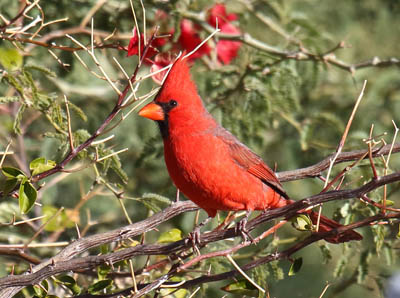
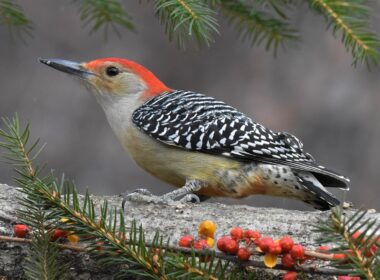
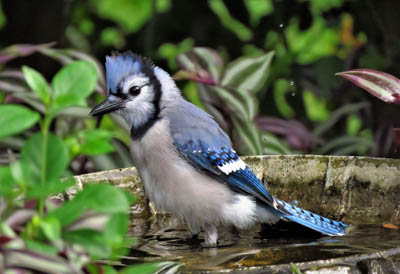
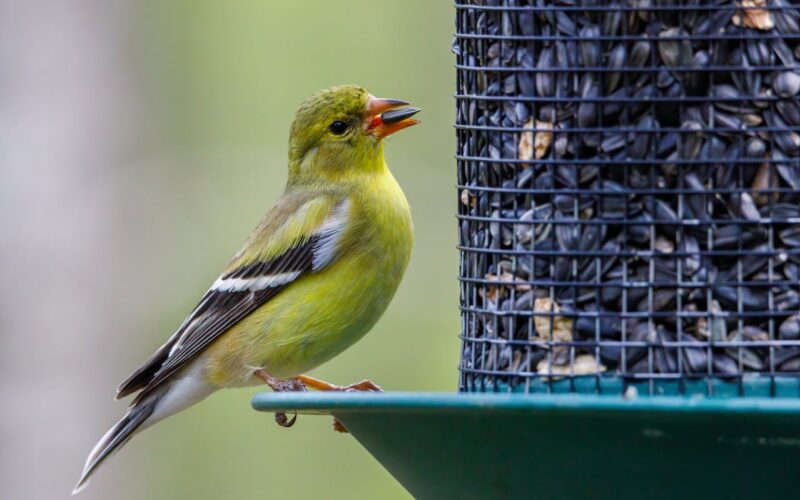
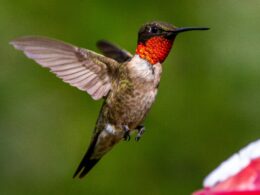
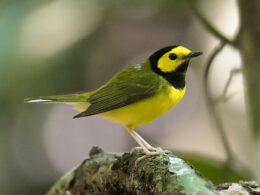
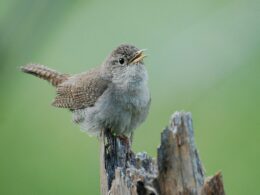
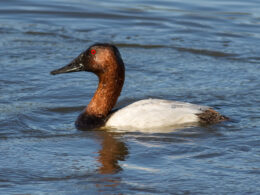
Thank you so much for building such a good website. I am new to bird watching and now having a home in a rural area on Vancouver Island, Canada I often see birds I do not recognise. This morning April 2nd I saw a an Evening Grosbeak at our bird bath. What a beauty. I will add to my list.
I just love the smoky black and golden yellow plumage of Evening Grosbeaks. Thanks for sharing!
Another open-field bird is the fabulous BOBOLINK. The stunning male is black and yellow… and white. It has a beautiful, bubbly song. Bobolinks migrate about 12,500 miles roundtrip each year, from northern U.S. and southern Canada, all the way to southern South America! It's one of the longest songbird migrations in the world. Quite impressive; so I am in awe when I see this bird and think of it's lengthy journey! Unfortunately their numbers are declining. —Ann in Wisconsin
Thanks, Ann.
You are right. Bobolinks are fabulous! I haven't seen any in about 8 years now. They nest about 300 miles from me, at Malheur NWR is SE Oregon in large wet meadows.
You did a really nice job on this site
Thanks. I continue to work hard on it.
We are watching our Western Tangers in our highest pine tree! Thanks to your site and pictures we know exactly what kind of bird they are!! Southwest Arizona.
Sorry southeast Arizona that is!
My bright yellow & black bird goes into my hummingbird feeder to drink. Weird.
I like sugary drinks myself!
Not the bird I saw it glimmered like gold with black tipped wings to large to be a finch and not like the 15 bird on the page
Sounds beautiful. No clue what it may have been. Not many birds glimmer like gold,… at least, not in the United States!
I saw a beautiful bird in my garden today. They had a black head and yellow breast. They looked very similar to a bullfinch. I live in England. Does anyone what birds this could be please? Many thanks
The bird in England is likely the Great Tit. It is related to Chickadees in North America.